by Ray Bodrey | Sep 8, 2017
Summer annual weeds are taking their last stand against Panhandle lawns before fall arrives. Rain and humid temperatures of late have boosted their growth spurts. Chamberbitter is a prime example.
Chamberbitter (Phyllanthus urinaria) is found as north as Illinois and as west as Texas, but thrives in lower southeastern states. It’s a headache for homeowners as well as pasture managers. This is an annual broadleaf weed that emerges in summer months. The foliage resembles that of the mimosa tree (Albizia julibrissin) and can be confused with the native mimosa groundcover, known as powderpuff mimosa (Mimosa strigillosa). This plant grows upright and develops a long taproot. Wart-like seeds can be found on the underside of the branch.
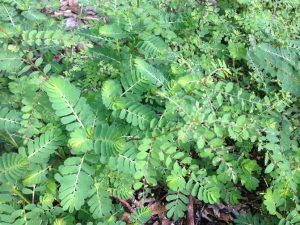
Figure 1: Chamberbitter, a common annual weed.
Credit: Mary Derrick, UF/IFAS Extension Santa Rosa County.
To control Chamberbitter in a lawn, one must not allow the seed to disperse. This plant germinates in warm soil temperatures. Therefore, it’s best to treat your lawn by applying a pre-emergent herbicide around April. An atrazine herbicide has an 80% effective rate. However, once weeds have germinated, a post-emergent herbicide would need to be applied. Turfgrass herbicides with 2,4-D (with dicamba & mecoprop or MCPP) or atrazine have good results. These are common chemicals and are represented by many brand names. However, both products need to be applied in cooler temperatures. Consecutive days of temperatures of less than 90 degrees are sufficient; otherwise the chemical will harm the turfgrass. Be aware, some formulations will injure or kill centipede and St. Augustine, but are safe to use on bermuda, bahia and zoysia. Be sure to read the label and follow the directions and precautions.
Non-selective, post-emergent herbicides, like glyphosate (Roundup) can be used in thick patches or for spot treatment. When using a non-selective herbicide, remember to protect turfgrass and other plants from spray drift or any contact, especially regarding ornamental plants and trees. Hand pulling of these weeds is an option, especially in flower beds. Do not shake the soil from the roots. In doing so, you may inadvertently spread seeds.
Soon, temperatures will be low enough to use a post-emergent herbicide for a control method. If you are having issues with chamberbitter or other summer annual broadleaf weeds, remember to plan to apply a pre-emergent herbicide this coming spring. Contact Gulf County Extension at 639-3200 for more information.
Information for this article is from the Clemson Cooperative Extension publication: “Chamberbitter”, Bulletin HCIC 2314: http://www.clemson.edu/extension/hgic/pests/pdf/hgic2314.pdf
UF/IFAS Extension is an Equal Opportunity Institution.
by Daniel J. Leonard | Aug 25, 2017
Northwest Floridians are lucky. We get to bask in the warm sunshine at least eight months of the year, consider it cold weather when we have to break out the fleece pullover and none of us live more than a few hours’ drive to the whitest sand you ever saw. However, those conditions have consequences. That warm sun and plentiful rain yields heat and humidity, a perfect breeding ground for all manner of pests and diseases, not to mention seriously cutting down on necessary chill hours required by many species. We’ll never be able to grow peaches like they do in Georgia. No one is in any danger of mistaking a Florida apple for one from Michigan. Pomegranates, olives, and nectarines like California? Forget about it. All of those species will mostly survive and grow but in most cases, the inputs of labor and protective chemicals greatly outweigh the output of fruit. For most of us it is just not worth the time and effort to turn a crop!
We have a couple of adapted, well-known stalwarts to turn to though. Any gardener worth his salt has a few productive rabbiteye blueberries (Vaccinium ashei), a pear (Pyrus communis), an old reliable fig tree (Ficus carica), and a citrus or two of some kind (though with the devastating disease known as Citrus Greening looming on the horizon, backyard citrus may decline in popularity in the near future). However, hobby fruit growers aren’t often content to stick to those standards though. We tend to be an adventurous, progressive lot, always looking for new species to grow and constantly pushing climatic and adaptation limits of species, with varying success. For the Panhandle backyard fruit orchardist looking for a little variety but demanding a high probability of success, there are three unusual Florida Friendly trees requiring little winter chill that fit the bill perfectly: Pawpaw (Asimina triloba), Japanese Persimmon (Diospyros kaki), and Loquat (Eriobtrya japonica).
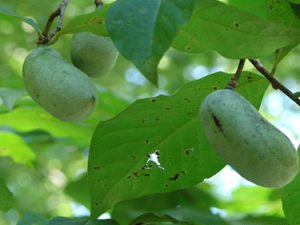
Pawpaw fruit
The pawpaw (yes it’s pronounced exactly like you think it is) is an altogether unusual tree. For starters, it is one of the most adaptable plants in cultivation, growing native from New York all the way down to the Sunshine State. It would be a beautiful tree if it never produced a single fruit; the large leaves droop naturally, lending a decidedly tropical feel to the garden and the understated purple-brown flowers are some of the more attractive of our native spring blooming trees. But, to be sure, the fruit are the real attraction here. Technically berries, the bluish-green, three to five inch long, oval-shaped fruit ripen in the late summer (August-October) and have an extremely unique taste often likened to banana or custard. Pawpaws occur naturally in moist, well-drained soils and thrive in both shade and sun; site accordingly and this unusual little native fruit tree should perform admirably for you!
While more common than Pawpaw, Japanese Persimmon still has not reached the cosmopolitan status of pear or fig or the like for reasons unclear to me! Native to eastern Asia, Japanese Persimmon is right at home in the Panhandle where it rewards gardeners each fall with outstanding reddish/orange foliage and a reliable crop of beautiful, baseball-sized, orange fruit possessing a crisp, sweet taste that can be eaten fresh or used in cooking. I especially like the fruit when it is made into a cakey “bread” similar to banana bread. It is a remarkably forgiving tree, growing and fruiting reliably with little help from the orchardist. Japanese Persimmon is generally sold as one of the selected cultivars, ‘Fuyu’ being the most common and probably the best. The species prefers full sun and moist, well-drained soil but does just fine without irrigation once it reaches establishment. A bonus, you only need to plant one as Japanese Persimmon does not require a pollinator! (Note: Persimmons can be astringent or non-astringent. If you plant an astringent cultivar, be sure to let the fruit ripen completely before eating as they are unpalatable until that point. Most are probably better off going with a non-astringent cultivar such as ‘Fuyu’.)
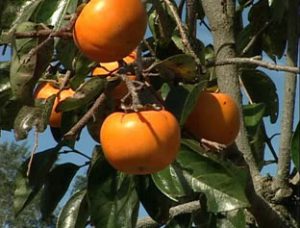
Persimmon fruit
A lesser-known gem of the coastal south, Loquat is hard to beat. It’s a great addition to the landscape, the cinnamon colored bark, foot-long “cabbagey” textured leaves and early spring flowers outdo many purely ornamental species. The yellowish-orange fruit that follow are outstanding picked and eaten fresh off the tree. Flavor is reminiscent of citrus with a sweet taste and a soft texture. Loquat flourishes in full sun and once established needs little to no supplemental fertilization or irrigation. As with Japanese Persimmon, Loquat is self-fertile and does not need a pollinator so just one tree will do (trust me, one healthy loquat will make enough fruit to feed a small army)!
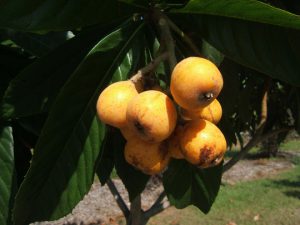
Loquat fruit
If you are indeed a backyard orcharding enthusiast and want to expand your horizons to include more than the same old standard species that everyone else grows or maybe you’re just frustrated with trying to grow popular but ill-adapted species like peach and apple, you could do a lot worse than including one or all of Pawpaw, Japanese Persimmon, and Loquat into your garden! For more information on fruit trees and any other horticultural questions you may have, contact your local UF/IFAS Extension office. Happy gardening!
by Daniel J. Leonard | Aug 11, 2017
Growing in containers can be one of the most versatile ways to add color, texture and mobility to the landscape. However, gardeners generally reach for finicky annuals to fill their pots with pizzazz. The problem with this strategy is that most annuals and perennials need to be watered constantly, fertilized regularly, and changed out with the seasons. That sounds like a little bang for a whole lot of buck! I and most of the real plant people I know fall squarely in the school of lazy gardening and believe there is an easier, less intensive, and ultimately less expensive way to get the same result. This can be accomplished by thinking outside the box and using an alternative class of plants that can fit the same bill of providing color and texture in pots without the headaches and have been sitting on the shelves right in front of us the whole time, the shrubs.
It is beyond me why shrubs aren’t used as container plants more often. Maybe the reason for the lack of use is pure perception; after all, no one with any sense would plant a giant, coarse green meatball or an enormous antebellum azalea in a decorative pot on their front walk. Recent innovations by plant breeders have left this argument moot though as new introductions of old species have revived interest in the entire group. Many of the best of these new cultivars sport traits perfect for container culture (dwarf growth habit, increased flowering, and interesting texture and form) while preserving the ironclad, undemanding nature of their parent plants. The following are a few of my favorite new shrub introductions for container growing!
- ‘Purple Pixie’ Loropetalum
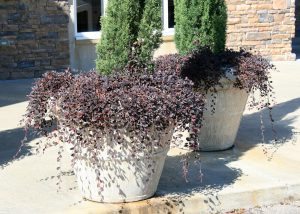
Purple Pixie loropetalum is a low-growing shrub that can spill beautifully out of a container. (Photo by MSU Extension Service/Gary Bachman)
If interesting architecture is what you require in a plant, ‘Purple Pixie’ must be on display in your yard. This dwarf cultivar of the wildly overused purple shrub Loropetalum chinense has taken the horticultural world by storm. The unique combination of true purplish foliage that only greens slightly in the hottest summer sun, ribbon-like pink spring flowers, and a graceful weeping habit make ‘Purple Pixie’ a winner. Give this plant a medium sized container (at least 12” in diameter), water when the soil begins to dry, fertilize infrequently with a slow-release formulation, site in full sun to partial shade, and enjoy for many seasons to come.
This is definitely not your granddaddy’s Ligustrum. Gone are the rampant growth, sickly sweet smelling flowers, and the aggressive nature of ‘Sunshine’s’ parent Chinese Privet (Ligustrum sinense). ‘Sunshine’ is a sterile cultivar with dwarf characteristics (growing 4-5’ with infrequent light pruning), vivid yellow-chartreuse foliage, and most importantly, no flowers. All ‘Sunshine’ asks of us is plenty of sun, occasional fertilizer and a light haircut once or twice a season! Use this plant to frame a dark flowerbed or in a container as a companion to the previous plant, ‘Purple Pixie’ Loropetalum for an extremely striking combination!
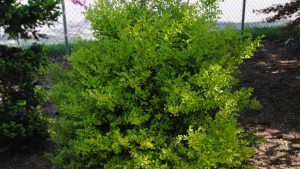
‘Sunshine’ Ligustrum. Photo courtesy of JC Raulston Arboretum.
A new take on a landscape standard, ‘Baby Gem’ is an exceptionally compact and slow growing cultivar of Buxus microphylla var japonica. All the same features gardeners love about traditional “full-size” boxwoods remains (tight, formal growth habit, ability to prune into many different shapes and ironclad constitution) but with ‘Baby Gem’ are delivered in a perfect package for a pot. This little “gem” of a plant is perfect for use in a smallish container to frame a formal landscape or to give a sense of order to an informal container garden or border!
So if you’re ready to stop replacing all of your potted plants each and every season, reach for one of these shrubs the next time you are at a garden center. You’ll likely be rewarded with compliments on your creativity, four season interest from the plants themselves, and more time to enjoy being in your garden instead of laboring in it! As always, if you have any questions about this or any other horticultural topics please contact your local UF/IFAS Extension office! Happy Gardening!
by Ray Bodrey | Aug 1, 2017
Many folks may not realize it at first, but everyone is using pesticides. Have you recently used a mold or mildew removal cleaner in your bathroom? Do you apply flea & tick powder to your pet? It is a misconception that only farmers, ranchers and lawn and garden enthusiasts are pesticide users. So, let’s all keep safety in mind, as any of these household and outdoor chemicals can be dangerous.
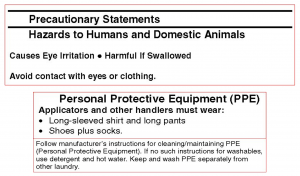
Example of Precautionary Statement and Personal Protective Equipment Instruction. Credit: UF/IFAS Extension
Pesticides include a wide range of products that either kill or repel pests. These pests can be insects, nuisance animals, weeds, plant pathogens, molds and other undesirables. Are pesticides necessary? Maybe not. Pesticides should be considered as a last resort. Using an integrated pest management (IPM) approach is an environmentally safe, and often, economical way to reduce pests. Usually, there are four steps involved in IPM, starting with the practice with the least environmental impact, until a solution to the pest problem has been found. For example, say that you are having issues with aphids in your garden. The IPM approach may begin with cultural measures (ex. avoiding high nitrogen fertilizer as it promotes lush growth that creates a favorable environment for aphids). This may be followed by mechanical measures (ex. use of insect netting) and if problem still exists, biological measures (ex. release of parasitic wasps). As stated earlier, the last resort would be chemical measures (ex. applying pesticide). There are varying IPM strategies for different pests. Please visit the UF/IFAS IPM website for more information: http://ipm.ifas.ufl.edu/
When pesticide usage is necessary, it’s important to select the right chemical(s). Once the pest has been identified, check pesticide labels under the section “pests controlled”. Never assume a pesticide will control a pest not listed under this section. Often, there are numerous products that list a common pest. Always consider five factors when determining the right pesticide: environmental friendliness, effects on beneficial organisms, ease of use, available application equipment and cost.
Once a pesticide has been chosen, be sure to follow the directions. It is critical to mix a concentrated pesticide accurately, therefore follow the product label. Diluting concentrated pesticides by mixing with water is necessary to achieve the correct concentration. Increasing the concentration is dangerous and will have a negative response. The response can be environmental harm, damage to desirable plants and beneficial organisms and above all, it’s illegal to apply rates greater than the specified label.
Remember, pesticide exposure can be life threating under certain circumstances. Pesticides can enter the body in several ways. The most common entries are mouth, inhalation, eyes or skin. Always wear personal protective equipment (PPE) when mixing and applying pesticides. Precautionary statements for humans and domesticated animals will be supplied on the product label. Examples of safety information are: causes eye irritation, harmful if swallowed or avoid contact with eyes or clothing. Dress accordingly based on the safety information supplied by the product label. Some types of PPE are long rubber gloves, goggles, respirators, waterproof apparel and rubber boots.
All pesticides should be stored out of the reach of children. Pesticides stored in any container not deemed pesticide compatible (ex. canning jars and food or soft drink containers) is illegal. For more information on pesticide safety and best management practices, contact your local county extension office.
Supporting information for this article can be found in the UF/IFAS EDIS publication: “Homeowner’s Guide to Pesticide Safety” by Frederick M. Fishel: http://edis.ifas.ufl.edu/pdffiles/PI/PI05100.pdf
UF/IFAS Extension is an Equal Opportunity Institution.
by Matt Lollar | Aug 1, 2017
The Jackson County Master Gardeners will host a “Gardening in Containers” Workshop on Saturday, August 19 from 9 AM to 2 PM at the Jackson County Extension Office, 2741 Penn Ave., Marianna, FL. The workshop will give you simple tips on growing vegetables, herbs, and flowers in containers. Bring your own unique container. Plant material and soil will be provided. The workshop is $25 and includes a home cooked lunch. Please see the flyer below for more details and call 850-482-9620 to pre-register.
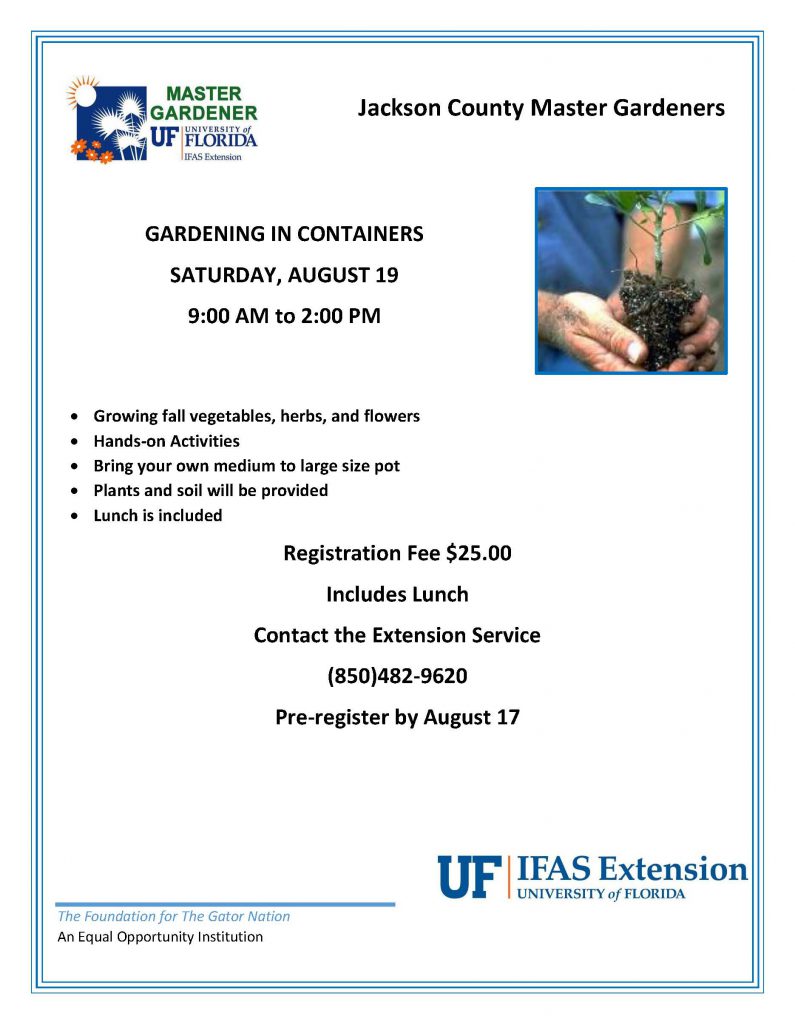
by Mark Tancig | Aug 1, 2017
Florida’s panhandle has received quite a bit of rain this summer. In the last three months, depending on the location, approximately 15 to 35 inches of rain have come down, with the western panhandle on the higher end of that range. In addition to the rain, we all know how hot it has been with heat index values in the triple digits. And who can forget the humidity?! Well, these weather conditions are just the right environmental factors for many types of fungi, some harmful to landscape plants, most not.
In the classification of living things, fungi are divided into their own Kingdom, separate from plants, animals, and bacteria. They are actually more closely related to animals than plants. They play an important role on the Earth by recycling nutrients through the breakdown of dead or dying organisms. Many are consumed as food by humans, others provide medicines, such as penicillin, while some (yeasts) provide what’s needed for bread and beer. However, there are fungi that also give gardeners and homeowners headaches. Plant diseases caused by various fungi go by the names rusts, smuts, or a variety of leaf, root, and stem rots. Fungal pathogens gardeners may be experiencing during this weather include:
- Gray leaf spot – This fungus can often show up in St. Augustine grass lawns. Signs of this fungus include gray spots on the leaf (very descriptive name!). This disease can cause thin areas of lawn and slow growth of the grass.
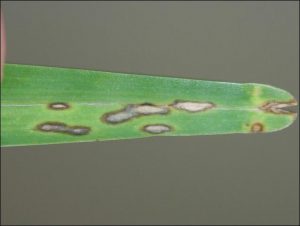
Gray leaf spot on St. Augustine grass. Credit: Phil Harmon/UF/IFAS.
- Take-all root rot – This fungus can attack all our warm-season turfgrasses, and may start as yellow leaf blades and develop into small to large areas of thin grass or bare patches. The roots and stolons of affected grasses will be short and black.
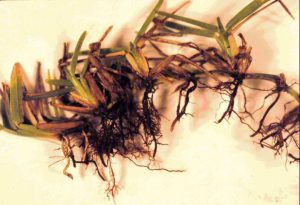
Signs of take all root rot. Credit: UF/IFAS.
Powdery mildew – This fungus can be found on many plants, from roses to cucumbers. It looks like white powder on the leaves and can lead to plant decline.
- Armillaria root rot – This fungus can infect a variety of landscape plants, including oaks, hickories, viburnums, and azaleas. Symptoms can include yellowing of leaves and branch dieback, usually in adjacent plants. Old hardwood stumps can harbor this fungus and lead to the infection of nearby ornamentals.
Because fungi are naturally abundant in the environment, the use of fungicides can temporarily suppress, but not eliminate, most fungal diseases. Therefore, fungicides are best used during favorable conditions for the particular pathogen, as a preventative tool.
Proper management practices – mowing height, fertilization, irrigation, etc. – that reduce plant stress go a long way in preventing fungal diseases. Remember that even the use of broadleaf specific herbicides can stress a lawn and exacerbate disease problems if done incorrectly. Since rain has been abundant, irrigation schedules should be adjusted to reduce leaf and soil moisture. Minimizing injury to the leaves, stems, and roots prevents stress and potential entry points for fungi on the move.
If you think your landscape plants are suffering from a fungal disease, contact your local Extension Office and/or visit the University of Florida’s EDIS website at http://edis.ifas.ufl.edu for more information.










